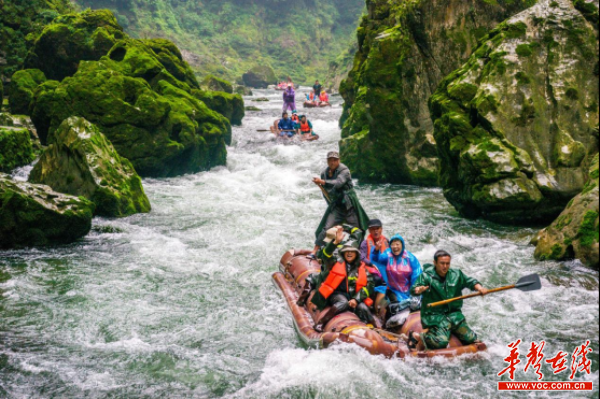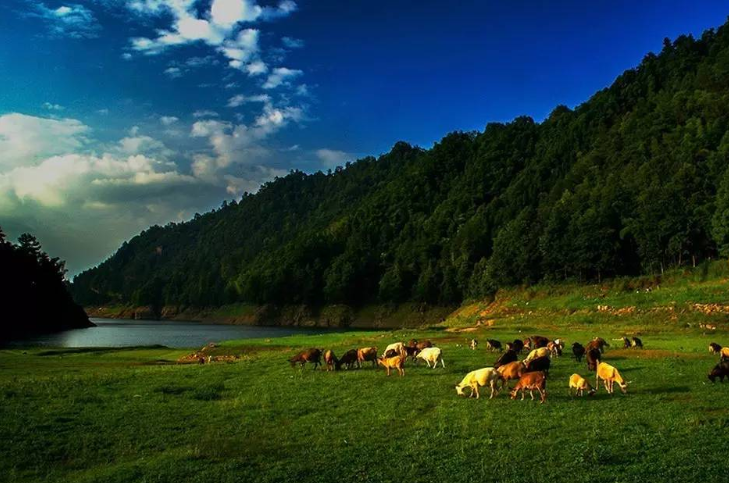Summer travel guide to Yongshun County
2022-08-01
Itinerary 1: “No. 1 Rafting Under Heaven”— Mengdong River rafting
The Mengdong River rafting stretches 17 kilometers, with marvelous and unique mountains and rivers across the scenic area and luxuriant primitive secondary forests along the river banks. There are two options of the Mengdong River rafting: one is the 2.5-hour regular rafting (12 people/boat) and the other is the 4-hour self-service rafting (2 people/boat). The ticket price is 183 yuan per person (including tourist bus fares). Everyone (including children) except soldiers and their families must buy full-price ticket.

July and August are peak seasons for rafting. The peak queuing period is from 1:00 p.m. to 5:00 p.m. on weekends, and the longest queuing time is about 2 hours. In order to avoid lining up during the peak hours, it is recommended to arrive at the Mengdong River before 9 o’clock in the morning.
There are restaurants with distinctive Tujia features in the scenic area. Recommended food: Tujia smoked meat, free-range chicken/duck, fish/shrimp of the Mengdong River, pickled cabbage, rice tofu and other Xiangxi specialties Recommended restaurant: Maoziping Firewood Restaurant (on the right side of the Tourist Service Center)
Itinerary 2: Furong Town—an Internet-famous site in Douyin
Formerly known as Wangcun Village, Futong Town is an ancient town with a history of over 2,000 years. As the first capital of the Tusi (a local official appointed by the central government in feudal China) Dynasty of Xizhou Tujia ethnic group, Furong Town saw a glorious history of the Tusi Dynasty over a span of 818 years. It is also called “the thousand-year-old town hanging on the waterfall” because there is a waterfall flowing through the town.

Tickets: 108 yuan per person (including costs of the carnival party of Blooming Lotus Bifzivkar); Package ticket: 236 yuan per person (including tourist bus fares, costs of tour around the Pinghu Lake and participation in the carnival party of Blooming Lotus Bifzivkar).
Heading toward Furong Town after rafting on the Mengdong River, you can experience the distinctive Tujia folk customs and the historical relics of the Tusi Dynasty, appreciate the stilted buildings on the cliffs and the thousand-year-old waterfall and wander around Wuli Stone Street. In Furong Town, you can relish the delicious Tujia food, stay in characteristic Tujia homestays, enjoy the night view of Furong Town and watch the “Blooming Lotus—Carnival of Bifzivkar”.
In Furong Town, you can savour the delicious Tujia food, including Liu Xiaoqing rice tofu, Xiangxi smoked bacon, sagebrush baba and dried fish of the Mengdong River. In the evening, you can stay at the homestay to experience Tujia customs.
Itinerary 3: World cultural heritage, a thousand-year-old Tusi legend—Laosicheng Site
Laosicheng Site is located on the banks of the Lingxi River, 19.5 kilometers east of Yongshun County, Hunan Province. It was the old capital of Peng’s Tusi regime of ancient Xizhou. During the Tusi period, it was the political, economic, cultural and military center of ethnic groups of Wuling Mountain in the southwest region. It had a splendid history of over 818 years and was one of the largest Tusi areas in the southeast region of ancient China.

Tickets: 118 yuan per person (including costs of museum tickets and tourist bus fares); price for taking wooden boats: 30 yuan for adults, 10 yuan for children under 1.2 meter or under 14 years old; price for taking rafts: 30 yuan for an hour (2 people/boat), 50 yuan for two hours (2 people/boat); self-service rafting: 100 yuan (2 people/boat).
The Galloping of Ten Thousand Horses is one of the scenic spots of Laosicheng Site because its surrounding mountain peaks are like ten thousand horses galloping toward Laosicheng. Besides, there are other tourist attractions like Laosicheng Museum, core heritage site, Zhoujiawan Hand-waving Hall and Patriarch Temple.
Itinerary 4: National Forest Park——Buermen
Located on the banks of the Mengdong River in the south of Yongshun County, Buermen National Forest Park has been known as “the No.1 rock of famous peaks in Hunan Province, the No.1 spring of well-known mountains and rivers” and “the only way toward Buddhism”. Buermen hot spring is situated at the Buermen National Forest Park and commonly known as “Hot Water Pit” by the locals. Combined with the Tujia regime of ritual Buddha bathing, Buermen hot spring forged the conception of “in Tujia Zen state, hot spring hidden in the forest”.

There are many renowned tourist attractions in Buermen National Forest Park, like Eight Battle Formation that includes 8 exits: Qian, Kun, Zhen, Xun, Kan, Li, Gen and Dui, which may pass through underground stone caves to form secret passages, or extend in the sprawling thick forests. The winding paths become clear at some places, and they seem to be endless at other places. In addition, there are Xixin Spring, Buer Stone Gate, cliff stone carvings and so on.
At Buermen, the food will impress you with distinctive local characteristics. Jingxianjv Restaurant has carried forward Hunan culture, with the specialties of prefectures as main dishes. The cooking takes new-style Hunan cuisine and Guangdong cuisine as the primary style, with original flavor and choice materials. The diverse seafood and the fresh ingredients enable you to savour the delicacy. The restaurants in the forest serve as dining bars to provide cold drinks and local snacks at daytime, and as pubs to offer self-service barbecue and music bars at night.


